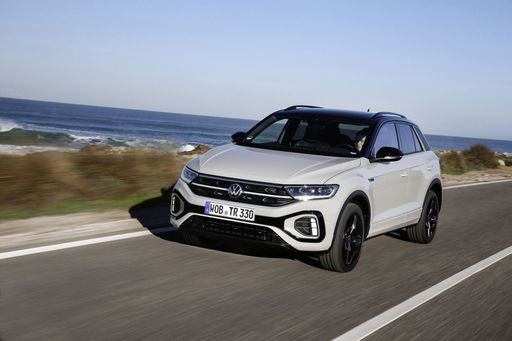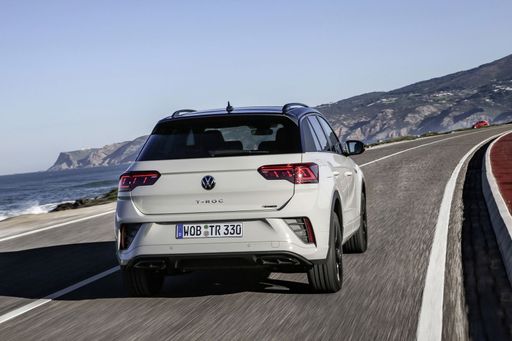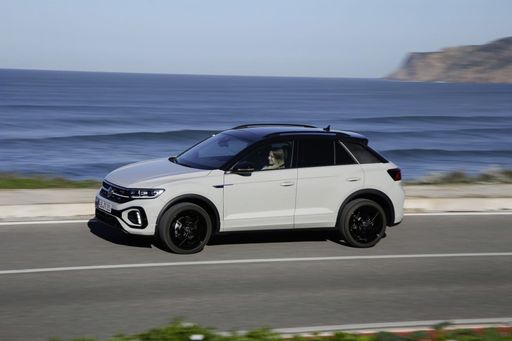VW T-Roc vs Fiat Grande Panda – Which car suits you better?
Two cars, one duel: VW T-Roc meets Fiat Grande Panda.
Which one wins in performance, efficiency and value for money? Find out now!
The Battle of the Compact SUVs: VW T-Roc vs Fiat Grande Panda
As the SUV trend continues to dominate global car markets, the competition has intensified among compact SUVs. Two contenders making waves in this category are the VW T-Roc and the Fiat Grande Panda. Both models offer a mixture of innovative features and robust performance. Let's dive deeper into what each brings to the table.
Design and Dimensions
The VW T-Roc and Fiat Grande Panda, while both SUVs, offer distinct styles. The T-Roc, with a body length of 4,271 mm, provides a refreshing blend of sporty elegance and modern design. Its width stands at 1,811 mm, ensuring a wide and authoritative road presence.
The Fiat Grande Panda, slightly shorter at 3,999 mm in length and 1,763 mm in width, exudes a more compact and urban-friendly aesthetic. It's taller than the T-Roc, with heights ranging up to 1,629 mm, providing an impressive road view for city driving.
Engine and Performance
The T-Roc offers a variety of engine types, including petrol and diesel options. With horsepower ranging from 115 to an exhilarating 300 HP, there's something for everyone. This model caters to varying driving preferences with a choice between manual and dual-clutch automatic transmissions, as well as front-wheel and all-wheel drive configurations.
On the other hand, the Fiat Grande Panda embraces modernity with its petrol MHEV and electric engines. Generating 101 HP from its petrol variant and 113 HP from the electric option, the Grande Panda strikes a harmonious balance between power and environmental responsibility. Its reduction gearbox automatic transmission pairs well with its front-wheel-drive configuration.
Fuel Efficiency and Sustainability
The VW T-Roc's petrol engines offer a consumption range from 5.6 to 8.5 L/100 km, aligning with its varied horsepower options, while diesel variants optimize efficiency further. Despite the versatile offerings, the CO2 efficiency class predominantly falls in the D to G range, reflective of its powerful engines.
Fiat's Grande Panda takes a greener approach, particularly with its electric model boasting a 320 km range on a full charge and a consumption rate of 17.4 kWh/100 km. Its petrol MHEV variant offers a respectable 5.4 L/100 km, and a favorable CO2 efficiency class spanning A to D, highlighting its commitment to sustainability.
Space and Comfort
Both SUVs accommodate up to five passengers, delivering comfort without compromising on space. The T-Roc offers a trunk capacity ranging from 284 to 445 liters depending on the model variation, while maintaining a plush interior experience.
The Grande Panda provides an accommodating trunk space from 361 to 412 liters, ensuring ample room for urban needs and weekend adventures. The ergonomically designed seating bolstered with Fiat's innovative approach ensures a comfortable ride.
Concluding Thoughts
Choosing between the VW T-Roc and the Fiat Grande Panda ultimately comes down to personal preference. The T-Roc excels in offering a broad range of powertrains and dynamic driving experiences, catering to those who value performance and presence.
Conversely, the Fiat Grande Panda appeals to eco-conscious drivers seeking an SUV that seamlessly blends urban practicality with sustainability. Its compact design, combined with the option of an efficient electric engine, positions it as a forward-thinking choice for the modern driver.
Both vehicles highlight how compact SUVs continue to evolve, offering diverse solutions that cater to a wide spectrum of consumer needs. Whether you're drawn to horsepower or ecological impact, both the T-Roc and the Grande Panda present compelling options in the segment.
Here’s where it gets real: The technical differences in detail
Costs and Efficiency: Looking at overall running costs, both models reveal some interesting differences in everyday economy.
Fiat Grande Panda has a convincingly advantage in terms of price – it starts at 16300 £, while the VW T-Roc costs 26400 £. That’s a price difference of around 10161 £.
Fuel consumption also shows a difference: the Fiat Grande Panda manages with 5.10 L and is therefore minimal more efficient than the VW T-Roc with 5.50 L. The difference is about 0.40 L per 100 km.
Engine and Performance: Power, torque and acceleration are the classic benchmarks for car enthusiasts – and here, some clear differences start to show.
When it comes to engine power, the VW T-Roc has a noticeable edge – offering 150 HP compared to 113 HP. That’s roughly 37 HP more horsepower.
In acceleration from 0 to 100 km/h, the VW T-Roc is slightly quicker – completing the sprint in 8.90 s, while the Fiat Grande Panda takes 10 s. That’s about 1.10 s faster.
In terms of top speed, the VW T-Roc performs clearly perceptible better – reaching 212 km/h, while the Fiat Grande Panda tops out at 160 km/h. The difference is around 52 km/h.
There’s also a difference in torque: the VW T-Roc pulls somewhat stronger with 250 Nm compared to 205 Nm. That’s about 45 Nm difference.
Space and Everyday Use: Cabin size, boot volume and payload all play a role in everyday practicality. Here, comfort and flexibility make the difference.
Both vehicles offer seating for 5 people.
In curb weight, the Fiat Grande Panda is to a small extent lighter – 1295 kg compared to 1465 kg. The difference is around 170 kg.
In terms of boot space, the VW T-Roc offers somewhat more room – 475 L compared to 412 L. That’s a difference of about 63 L.
In maximum load capacity, the Fiat Grande Panda performs slight better – up to 1366 L, which is about 16 L more than the VW T-Roc.
When it comes to payload, VW T-Roc a bit takes the win – 515 kg compared to 453 kg. That’s a difference of about 62 kg.
All in all, the VW T-Roc shows itself to be dominates this comparison and secures the title of DriveDuel Champion.
It impresses with the more balanced overall package and proves to be the more versatile companion for everyday use.
VW T-Roc
The VW T-Roc seamlessly blends stylish design with practical functionality, making it an ideal choice for those who enjoy both urban and countryside driving. Its modern interior features intuitive technology and comfortable seating, enhancing the overall driving experience. With its robust build and dynamic performance, the T-Roc is equipped to handle various road conditions with confidence.
details @ Volkswagen
@ Volkswagen
 @ Volkswagen
@ Volkswagen
 @ Volkswagen
@ Volkswagen
 @ Volkswagen
@ Volkswagen
Fiat Grande Panda
The Grande Panda is a delightful blend of practicality and charm, making it a popular choice for urban dwellers and families alike. With its compact design, the car navigates city streets effortlessly while providing ample interior space for passengers and cargo. Its quirky styling and user-friendly features make the Grande Panda not just a mode of transport, but a fun driving experience.
details

|
|
|
|
|
Costs and Consumption |
|
|---|---|
|
Price
26400 - 38000 £
|
Price
16300 - 24000 £
|
|
Consumption L/100km
5.5 - 6.3 L
|
Consumption L/100km
5.1 - 5.7 L
|
|
Consumption kWh/100km
-
|
Consumption kWh/100km
16.80 kWh
|
|
Electric Range
-
|
Electric Range
320 km
|
|
Battery Capacity
-
|
Battery Capacity
43.80 kWh
|
|
co2
126 - 143 g/km
|
co2
0 - 130 g/km
|
|
Fuel tank capacity
50 L
|
Fuel tank capacity
44 L
|
Dimensions and Body |
|
|---|---|
|
Body Type
SUV
|
Body Type
SUV
|
|
Seats
4 - 5
|
Seats
5
|
|
Doors
2 - 5
|
Doors
5
|
|
Curb weight
1465 - 1539 kg
|
Curb weight
1295 - 1554 kg
|
|
Trunk capacity
284 - 475 L
|
Trunk capacity
361 - 412 L
|
|
Length
4271 - 4373 mm
|
Length
3999 mm
|
|
Width
1811 - 1828 mm
|
Width
1763 mm
|
|
Height
1527 - 1573 mm
|
Height
1581 - 1629 mm
|
|
Max trunk capacity
1350 L
|
Max trunk capacity
1315 - 1366 L
|
|
Payload
368 - 515 kg
|
Payload
353 - 453 kg
|
Engine and Performance |
|
|---|---|
|
Engine Type
Petrol, Petrol MHEV
|
Engine Type
Petrol MHEV, Electric, Petrol
|
|
Transmission
Manuel, Automatic
|
Transmission
Automatic, Manuel
|
|
Transmission Detail
Manual Gearbox, Dual-Clutch Automatic
|
Transmission Detail
Dual-Clutch Automatic, Reduction Gearbox, Manual Gearbox
|
|
Drive Type
Front-Wheel Drive
|
Drive Type
Front-Wheel Drive
|
|
Power HP
115 - 150 HP
|
Power HP
100 - 113 HP
|
|
Acceleration 0-100km/h
8.9 - 12.3 s
|
Acceleration 0-100km/h
10 - 11.5 s
|
|
Max Speed
187 - 212 km/h
|
Max Speed
132 - 160 km/h
|
|
Torque
200 - 250 Nm
|
Torque
122 - 205 Nm
|
|
Number of Cylinders
3 - 4
|
Number of Cylinders
3
|
|
Power kW
85 - 110 kW
|
Power kW
74 - 83 kW
|
|
Engine capacity
999 - 1498 cm3
|
Engine capacity
1199 cm3
|
General |
|
|---|---|
|
Model Year
2024 - 2025
|
Model Year
2025
|
|
CO2 Efficiency Class
E, D
|
CO2 Efficiency Class
D, A
|
|
Brand
VW
|
Brand
Fiat
|
Is the VW T-Roc offered with different drivetrains?
Available configurations include Front-Wheel Drive.
The prices and data displayed are estimates based on German list prices and may vary by country. This information is not legally binding.
